2012-12-17
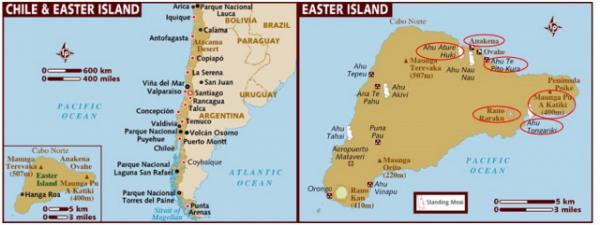
【Aiden in English】
Today was my first day exploring South America after connecting a series of flights for more than 23 hours. As soon as I stepped off the plane on Easter Island in the Pacific Ocean—the Navel of the World—I knew this would be an extremely hot trip (not including Antarctica). When I woke to the rooster's morning chorus of "COCK-A-DOODLE-DOO", I was surprised that breakfast time had already started at my hotel, Explora Rapa Nui. We walked to the restaurant after getting dressed and putting on our shoes. My mom ordered a well-done fried egg, but she didn't like a raw yolk at all. I had an omelet with cheese, tasty ham, and fresh mushrooms. It was an excellent meal for a king. As I accompanied our morning tour guides, no other people were with us. I thought the tour I talked about with my mom was popular. But oh, how wrong I was. No one came to join us. So, at 9:30 am, we left our hotel to see the Moai in Rapa Nui National Park, designated as a UNESCO (United Nations Educational, Scientific, and Cultural Organization) heritage site. Moai means "the Living Face" in Polynesian, and the stone statues are carved and shaped like human statues. Some Moai seemed to be unique, and others looked like each other. I learned that about 1,000 years ago, different Rapa Nui tribes lived on Easter Island. Each tribe carved its respective leader differently from the rest of the tribes. There were supposed to be 15 Moai at Ahu Tongariki, the most popular sport in the world. But when I counted, it had 17. One was lying down, and another was apart from a group of 15 Moai standing on a platform next to each other. All had some resemblance facing inland. The one standing apart from the others had a unique name, Traveler. He had a long journey to Japan to raise money for the Moai restoration. Back in 1250-1500, when the Rapa Nui native people still carved the Moai statues, an earthquake hit this area severely and knocked all the Moai over. Since some weighed over a ton, the Rapa Nui couldn't lift them without exceptional help. So, the Traveler sailed to Japan and toured the country for monetary collection. With Japanese support, 15 Moai could stand up to the original position. I asked the tour guide why the one lying down was not lifted simultaneously. According to his legendary explanation, the islanders had to carry them down from the Quarry to their Ahu, or the platform at the seaside, where the Moai stood after the Moai were made. Each Moai represented an ancestor of a new king or the current king. It was believed that every Moai had its energy. If the stone statue fell during transportation, a new one would be sculpted, and the fallen one would be left there. No one touched the hard stone for bad luck. On the way to the beaches, we stopped by Ahu Te Pito Kura, or the navel of the world, where the largest Moai ever transported was. It was 10 meters long and weighed over 82 tons. I followed our guide to a magnetic rock that made for a compass. It's said that this was one of the three rocks that the first king brought to Easter Island. When they came near each other, they formed a portal in another dimension and became the center of the Earth. However, the 2nd was lost over the centuries, and the 3rd was missed in the Pacific Ocean. What a fascinating story I had just heard! We passed by Ovahe Beach, which had no sand. In winter, the intense waves sucked out the sand into the ocean. In summer, it spits the sand out from the sea. When we visited, it was too early for the sand to return to the shore. It's a pretty odd and mysterious phenomenon if you ask me. Then, we headed for Anakena, the only beach suitable for swimming on Easter Island. Once we arrived, I jumped out of the car and ran into turquoise shallows without a second thought. The water seemed so cold that it set my teeth shivering. I immediately popped out as fast as my tired legs would carry me to the shore. I stood gasping for breath and heaving for air. I'd rather spend the rest of my time playing in the white sand under the sunshine. For lunch, I ate at the hotel. The green vegetable salad seemed so bitter that I needed to dump salt onto my tongue and wash it down with gulps of water. Other than that, everything looked good. The roasted tuna became my great favorite. With black pepper, salt, and rice, it tasted delicious! When the time came to meet our afternoon tour guide, I noticed a big difference in the size of our group. There were four times as many tourists as one hour before! As I arrived at Rano Raraku or Quarry, my eyes widened. In front of my eyes, an enormous crater was displayed with Moai along the sides. The tour guide, a Rapa Nui native lady, must have seen a look of amazement on my face. The next moment, she said, "Let's climb that." Before I knew it, I stared in disbelief at the large hole. "Am I supposed to climb that tall edge?" I asked myself. When my mom called for me to move, I bolted toward her and ran up the steepest slope until I was out of energy. A large stone statue was shown off in front. It didn't draw my attention until I was shocked to hear about a particular piece of information. This rock was a Moai! It was approximately 21 meters high. However, it lay along the hill and blended in with its surroundings, which almost fooled me early on. We trekked on a small trail to the crater's top and sloped down toward the center. The view turned out spectacular! There was a clear blue lake with trees around it. The ground looked red. The red soil generated not only a lot of dust but also helped to elevate the temperature. Here, it was brutally hot. As I descended from the crater, I tripped twice, fell once, and got scratched a dozen times. The dirt made the steep walk easy to fall on, and the sharp edges of the tree branches made me feel itchy. At the end of our sightseeing, we enjoyed the cold and sweet fruit juice that the tour guide brought from our hotel. After three prolonged droughts, I started toward the green van. Soon, I returned to the hotel in no time. 【红霞译】 今天在经历23小时连续转乘飞机之后,出游南美的第一天终于到来了。一走进位于太平洋号称“地球肚脐”的智利“土地的尽头”复活节岛时,我立刻意识到,如若排除南极不计,这将是一趟战高温斗酷暑的旅行。
清晨,屋外公鸡喔喔叫个不停,把我从睡梦中吵醒,才知早餐临近,我们梳理打扮,穿好行装,立刻赶往复活节探险酒店餐厅。妈妈要来一份炸熟的荷包蛋,她一点都不喜欢吃生蛋黄;我点了奶酪火腿蘑菇煎蛋,味道鲜美得足以供奉国王。 我紧随上午导游其后,发现除我们之外,没有任何人将与我们同行,本以为要去的景点非常流行,一定会有很多游客前往,我真看走了眼。九点半钟,我们动身朝复活节岛国家公园进发,那里因摩艾石像而引人注目,被世界科教文组织列为《世界遗产名录》。
摩艾在波里尼西亚“多岛”语的意思是“活脸谱”,巨人石像刻得跟现代人形一样,只是摩艾与摩艾之间模样有所不同。据说大约1,000年前复活节岛有很多土著部落,每个部落都有各自敬拜的酋长首领。阿胡·通加里基“东风祭坛”有15个摩艾,是当今世界上最大的巨石雕像群,可我仔细清点过,一共有17个才对,第16个躺在地上,最后一个名叫“旅行家”的摩艾则站在远处,后者之所以被称作“旅行家”,是因为它曾远渡重洋,只身到日本游说募集资金,为摩艾石像修复工程做出了重大贡献。
追溯到公元1250至1500年间,复活节岛土著部落正热衷打造自己的摩艾石像,地震严重破坏了岛民生活,震塌了岛上所有石像。不少石像重达一吨以上,当地人根本无法让石像重新矗立起来。于是,“旅行家”周游日本诸地,不仅唤起了民众对濒危文物的广泛关注,同时还赢得了株式会社的经济赞助。正由于日本企业家鼎力出资,才让15个摩艾石像再度获得新生。我问起为什么没有扶起躺在地上的那个摩艾石像?导游根据民间传说解释道,当岛民将刻好的石像从火山采石场运往海边祭坛的过程中,一旦石像不幸倒地,人们不许将它扶起,而只能重新打造另外一个。复活节岛人认为,每一个首领都有自己超自然的力量,任何人都无法改变这种神威,否则定会天诛地灭。
在去海滨的路上途经蒂皮托库拉“世界肚脐”,我们看到复活节岛上被运出采石场的最高摩艾石像,它全长10米,重量超过82吨。我跟随导游来到一块用作指定方向的磁石旁,听他讲述古老传说:复活节岛首位酋长曾从家乡带来三块这样的圆形石头,当三块岩石拼在一起,会变成地标──地球中心。遗憾地,这是唯一幸存的岩石,另外两块不是几百年前便不知去向,就是早已葬身茫茫太平洋之中,故事听起来多么不可思议!
欧瓦赫“隐藏的宝石”海滩的沙子随季节的变化而变化,冬季海浪把白沙活生生地吞嗜入海,直到夏季才把卷走的白沙退还回来,可我们来得时节稍早,海浪尚未来得及把全部白沙完璧归赵,你说大自然邪乎不邪乎?接着,我们直奔复活节岛唯一可以游泳的白沙滩海滨。车子刚刚停稳,我便迫不及待跳入蓝绿色海洋之中。天哪,海水刺骨,冻得牙齿上下不停地打架,我赶紧蹦出水面,拖着疲惫的身躯,三步并作两步逃往沙滩。我张开大口喘着气,好半天都缓不过劲来。说真格的,我情愿待在岸边沐浴阳光。
午餐时分,我们返回酒店下榻。绿色沙拉苦不堪言,我恨不能拿起盐罐直接往舌头上洒,然后再用清水漱口,除此之外一切安好,烧烤的金枪鱼味道真棒,再拌上少许黑胡椒、咸盐和米饭,喷香诱人美不胜收!
转眼功夫就到了与下午导游会合的时候,我立马注意到眼前游人骤增,大概是上午的四倍。我们驱车来到拉诺•拉拉库“槽型火山口”采石场,眼前出现的景观叫我瞠目结舌,偌大死火山口脊背上布满了各式各样的摩艾石像。导游阿姨是当地土著,一定看到我满脸惊喜便趁机对我说一起爬上去,我茫然地站在原地不知所措,“能行吗?”我下意识地揣度自己,一点信心也没有。恰在这时,妈妈带头前行,我箭步如飞,一口气跑过最陡峭的山坡,累得呼哧带喘精疲力竭,这时身边出现一块巨石,没想到竟是全岛最大的摩艾石像,这位身高21米的家伙正仰面躺在半山腰乱石丛中,让我难辨庐山真面目。
我们沿着相反方向徒步走过一小段山路,很快爬上火山湖正面。湖水湛蓝,山林青翠,土壤火红,出落得自然秀美!被太阳烘焦的地面尘土飞扬,不时卷起滚滚热浪,令人倍感酷暑难熬。下火山口的时候,我差点绊倒两回、摔跤一次、被灌木丛刮了不止半打乎,斜坡上浮尘滑得要命,让我很难站稳脚跟;身边树杈末梢又特别尖利,我不得不高度警惕,否则皮肤被刺挠得奇痒无比。 观光结束后,导游给我们每人送上从酒店带来清凉爽口的水果饮料,久旱逢甘霖,我连喝三杯,随即登上绿色面包车,一溜烟跑回酒店。
【后语】 对于正在美国接受教育的小学生来说,一年到底有多少写作练习?究竟怎样培养文字表达?一直是我十分好奇的话题。 从一年级到四年级,每当春秋两季开家长会的时候,我都会面对不同的老师询问同样的问题。显然,我关注的既不是人人爱好的数学计算,也不是个个厌倦的语文词汇,而是很少能从考试成绩反映出来、却极易被大家忽视的写作能力。
过去四年来,我发觉班主任的教学心境,决定了适龄学童的作文水平。具体地讲,年纪越大的老师往往擅长启发孩子观察事物的好奇心,有助于调动孩子抒发情感,进一步拓展想象力,因为她们更花精力来发掘大家的学习兴趣,更有心情去放飞各自的梦想,似乎与教学经验并无太大关系,我家童少二、三年级两届班主任便属于这样的老师。相反,年纪越轻的老师不是忙于恋爱结婚,就是疲于家务缠身,一旦自己也有2~3个小不点需要照顾,最终能够按照教学大纲指导全班差不多20几口子写作,已经算是学生们莫大的造化,而儿子一年级和现在四年级的老师恰好处在这个时期。
如果有一天你像我一样发现,即使博览着书刊杂志,游历过名川大山,体验了五味生活,观察到自然景象,孩子依然漫天刷浆糊,毫无厚集薄发之举,那么你我都不必大惊小怪,因为写作的门径贵在练习,只有长期坚持,才会有话可说,才能有物可写,才使笔下生花。
这次出游南美四个星期,我家童少每天花少许时间练习写作,随时记录所见所闻所为所感,有话则长,无话可短,尽兴而写,随意且止。孩子一路走、一路看、一路写、一路成长,留下不少游记观感、心得体会、日记报道、随笔散文,收获了大量课外教育所期待的珍贵记忆。
Today in History(历史上的今天): 2009: 新西兰天籁之声(Sounds of Heaven, NZ)  Agricultural Plantation (农业种植园) Agricultural Plantation (农业种植园)
 Puna Pau,the Sole Source of the Red Scoria to Be Carved for the Pukao Puna Pau,the Sole Source of the Red Scoria to Be Carved for the Pukao
(无树高地采石场·唯一出产红色火山渣石顶结的地方)
 More Horses than People on Easter Isalnd More Horses than People on Easter Isalnd
(复活节岛上马比人多 12-16-2012)  Dam & Foal (母马与马驹 12-16-2012) Dam & Foal (母马与马驹 12-16-2012)
 Puna Pau, a Cinder Cone at the Distance Puna Pau, a Cinder Cone at the Distance
(普纳帕乌“干泉”采石场·远处为火山渣锥 12-16-2012)  Poike Volcano, One of the 3 Main Extinct Volcanoes Forming Rapa Nui @ 370 Metres/1,214 Ft above Sea Level as the Island's 2nd-Highest Point After the Peak of the Extinct Volcano Terevaka Poike Volcano, One of the 3 Main Extinct Volcanoes Forming Rapa Nui @ 370 Metres/1,214 Ft above Sea Level as the Island's 2nd-Highest Point After the Peak of the Extinct Volcano Terevaka
(波伊克“黎明的地方”火山·拉帕努伊“复活节岛”的三座主要死火山之一,以海拔370米/1,214英尺居本岛第二高峰,仅次于死火山特雷瓦卡“推/拉独木舟”峰 12-16-2012)  Free-Range Cattle (放养牛群 12-16-2012) Free-Range Cattle (放养牛群 12-16-2012)
 South Coast (南海岸 12-16-2012) South Coast (南海岸 12-16-2012)
 Explora Rapa Nui (复活节岛探索酒店 12-16-2012) Explora Rapa Nui (复活节岛探索酒店 12-16-2012)
 Bar of Explora Rapa Nui Bar of Explora Rapa Nui
(复活节岛探索酒店·吧台 12-16-2012)  Rapa Nui Natl Park (复活节岛国家公园 12-17-2012) Rapa Nui Natl Park (复活节岛国家公园 12-17-2012)
 Ahu Tongariki w/ 15 Moais along the Southern Coast Ahu Tongariki w/ 15 Moais along the Southern Coast
(阿胡·通加里基——位于南海岸的15位巨石雕像)  Ahu Tongariki, the Largest Ahu on Easter Island along the Sundown toward the West & the Sunrise against the East @ the Spring Equinox Ahu Tongariki, the Largest Ahu on Easter Island along the Sundown toward the West & the Sunrise against the East @ the Spring Equinox
(阿胡·通加里基——复活节岛最大的巨石雕像群 | 春分时面向西方日落的夕阳背朝东方日出的朝霞 12-17-2012)  Fish Petroglyph @ Ahu Tongariki Fish Petroglyph @ Ahu Tongariki
(阿胡·通加里基——鱼岩画 12-17-2012)  Ahu Tongariki, the Main Ctr & Capital of the Hotu-iti Clan Ahu Tongariki, the Main Ctr & Capital of the Hotu-iti Clan
(阿胡·通加里基——霍图伊蒂“小火土”族的中心与首府 12-17-2012)  Moai Fallen in Front of Rano Raraku @ Rapa Nui NP Moai Fallen in Front of Rano Raraku @ Rapa Nui NP
(复活节岛国家公园·第16位摩艾倒在槽型火山口下)  Traveler Moai @ Rapa Nui NP Traveler Moai @ Rapa Nui NP
(复活节岛国家公园·旅行家摩艾) 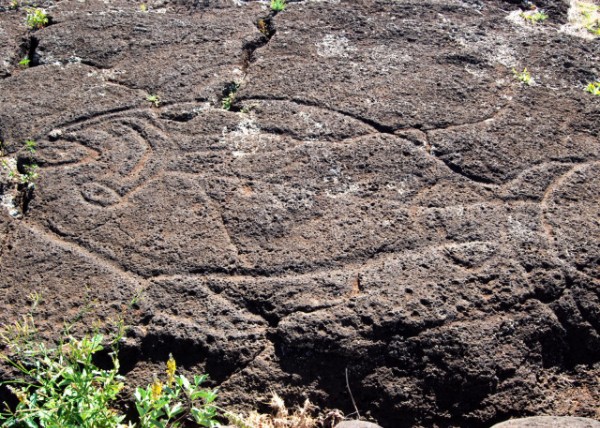
Tuna Fish @ Papa Vaka Petroglyph (帕帕·瓦卡“石头·独木舟”岩画石刻——金枪鱼) 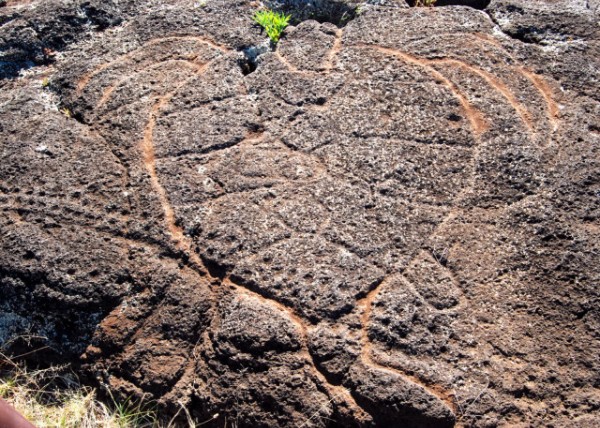
Sea Turtle @ Papa Vaka Petroglyph (帕帕·瓦卡岩画石刻——海龟) 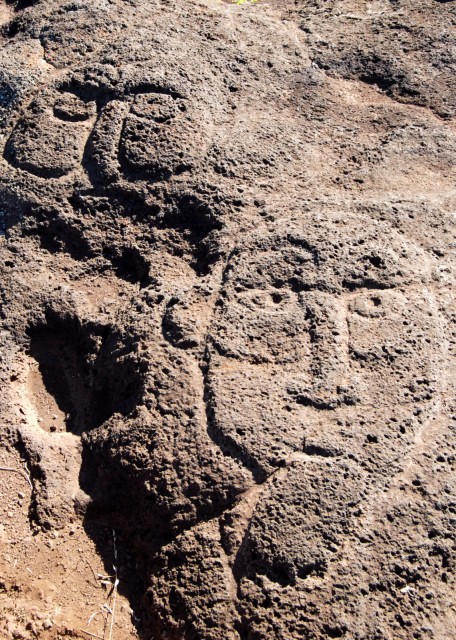
Indigenous People @ Papa Vaka Petroglyph (帕帕·瓦卡岩画石刻——土著)  Typical Landscape on Easter Island w/ Rounded Extinct Volcanoes Covered in Low Vegetation Typical Landscape on Easter Island w/ Rounded Extinct Volcanoes Covered in Low Vegetation
(复活节岛典型景观·圆形死火山覆盖着低矮植被)  Paro Moai, the Tallest Moai Transported out of Quarry Paro Moai, the Tallest Moai Transported out of Quarry
(帕罗摩艾石像·被运出采石场最高的摩艾 12-17-2012)
 Ahu Te Pito Kura (世界肚脐所在地 12-17-2012) Ahu Te Pito Kura (世界肚脐所在地 12-17-2012)
 Ahu Te Pito Kura & Te Pito o te Henua @ Bay of La Pérouse Ahu Te Pito Kura & Te Pito o te Henua @ Bay of La Pérouse
(拉佩鲁兹“多石之地”湾·世界肚脐与能量石 12-17-2012)  Boulder Beach @ Bay of La Pérouse Boulder Beach @ Bay of La Pérouse
(拉佩鲁兹湾·鹅卵石海滩)
 Ahu Nau Nau in 7 Moais, Some Topped w/ Red Pukao or Hheaddresses Made of Scoria Ahu Nau Nau in 7 Moais, Some Topped w/ Red Pukao or Hheaddresses Made of Scoria
(阿纳凯纳“武士”祭坛·七位摩艾, 有的石像顶部还戴着红色的普卡奥“用火山渣制成的头饰” 12-17-2012)  Ahu Nau Nau w/ the Red Scoria Topknots Ahu Nau Nau w/ the Red Scoria Topknots
(阿纳凯纳祭坛·红火山渣石顶结)  Ahu Ature Huki the 1st Re-Erected Moai in Modern Times on Anakena Beach Ahu Ature Huki the 1st Re-Erected Moai in Modern Times on Anakena Beach
(拉帕努伊“洞穴”海滨阿胡阿图雷胡基·当今第一座重新竖立的摩艾石像)  Anakena Beach, the 1st Polynesian Settlers Landed on Easter Island & the Birthplace of Rapa Nui's Culture Anakena Beach, the 1st Polynesian Settlers Landed on Easter Island & the Birthplace of Rapa Nui's Culture
(拉帕努伊沙滩·首批波利尼西亚定居者登陆复活节岛的地方 | 复活节岛文化发源地 12-17-2012)  Anakena Beach, Too Cold To Swim Anakena Beach, Too Cold To Swim
(拉帕努伊沙滩·水温低到不适于游泳 12-17-2012) 
Palm Grove @ Anakena Beach (拉帕努伊沙滩·棕榈林 12-17-2012)  Ovahe Beach Seasonally w/ No Sand Ovahe Beach Seasonally w/ No Sand
(欧瓦赫海滨·季节性无沙海滩 12-17-2012)
 Terevaka, the Island's Largest, Tallest, & Youngest Extinct Volcano @ 507.41 Meters/1,664.73 Ft Terevaka, the Island's Largest, Tallest, & Youngest Extinct Volcano @ 507.41 Meters/1,664.73 Ft
(特雷瓦卡峰·岛上最大、最高且最年轻的死火山,507.41米/1,664.73英尺)  Rano Raraku Quarry Rano Raraku Quarry
(拉诺·拉拉库采石场 12-17-2012)

Moais @ Rano Raraku Quarry (拉诺·拉拉库采石场·摩艾 12-17-2012) 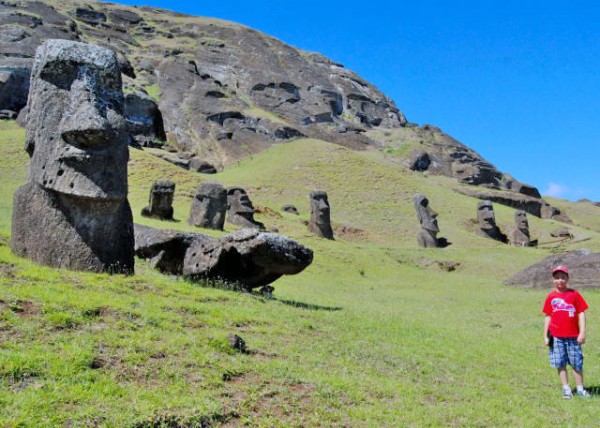
Many Uncompleted Moai Statues @ Rano Raraku Quarry (拉诺·拉拉库采石场·许多未完成的摩艾石像 12-17-2012) 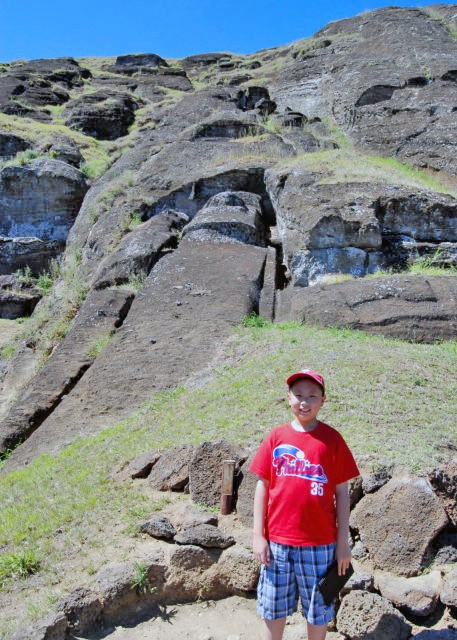
Largest Moai in 21-m/69-ft @ Rano Raraku Quarry (拉诺·拉拉库采石场·21米/69英尺最长的摩艾 12-17-2012)  Outer Slopes of Rano Raraku w/ Moais in Half-Buried & Still under Construction Outer Slopes of Rano Raraku w/ Moais in Half-Buried & Still under Construction
(拉诺·拉拉库采石场——外山坡上半埋的、尚在建设中的摩艾) 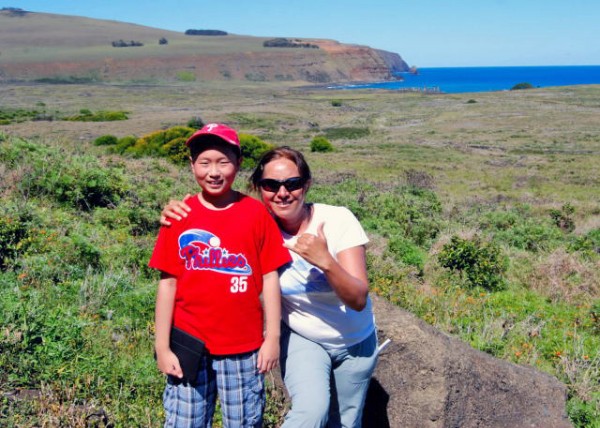
Poike & Ahu Tongariki in Distance @ Rano Raraku Quarry (拉诺·拉拉库采石场——土著导游,背景为波伊克火山与巨人石雕群)  Freshwater Lake @ Rano Raraku Freshwater Lake @ Rano Raraku
(拉诺·拉拉库采石场——淡水湖 12-17-2012) 
Roasted Tuna for Lunch @ Explora Rapa Nui (复活节岛探索酒店·烤金枪鱼午餐 12-17-2012)  Dinner @ Explora Rapa Nui Dinner @ Explora Rapa Nui
(复活节岛探索酒店·晚餐 12-17-2012)
 Library @ Explora Rapa Nui (复活节岛探索酒店·阅览室) Library @ Explora Rapa Nui (复活节岛探索酒店·阅览室)
Crosslinks(相关博文): Chile(出游智利)
South America(漂流南美洲) 小学四年级(4th Grade) |
